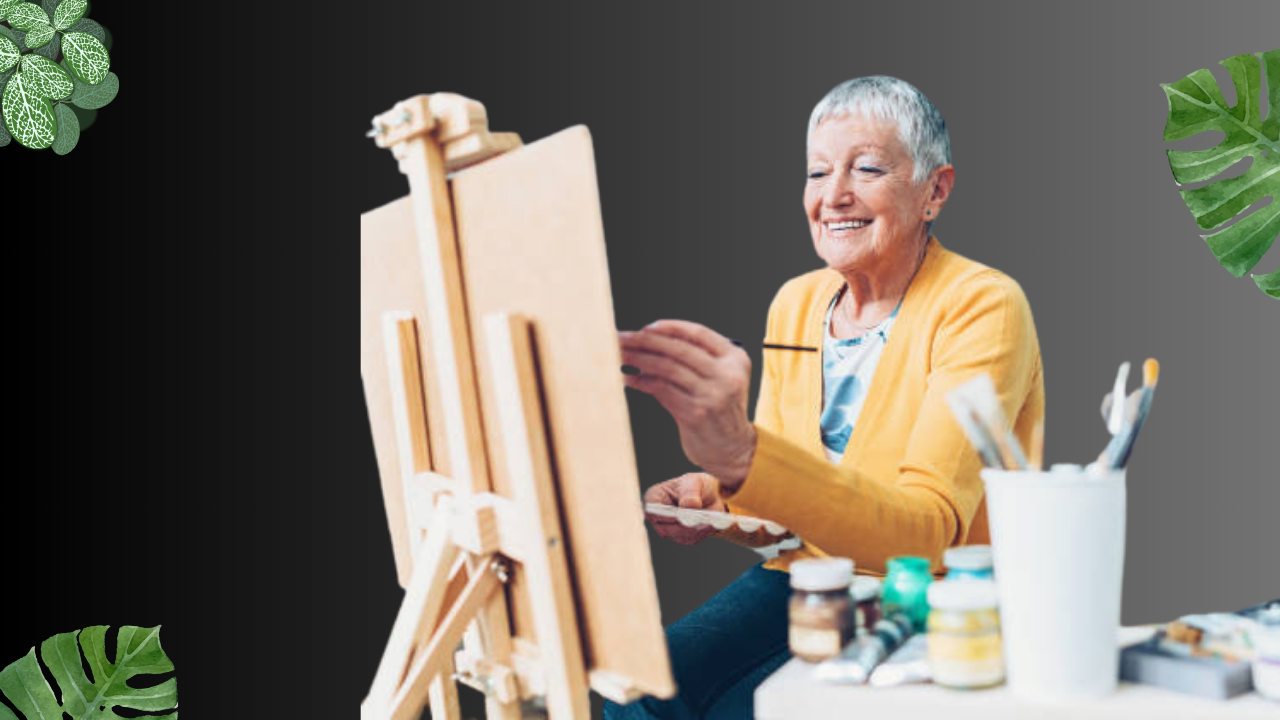Art has no age limit. It’s a powerful medium for self-expression, relaxation, and cognitive stimulation, making it an ideal activity for seniors. Whether you’re a caregiver, family member, or a senior yourself, exploring various art forms can bring joy, improve mental well-being, and foster social connections. Let’s dive into a world of colorful possibilities with these engaging art activities tailored for seniors.
1. Painting
Painting is a versatile and accessible art form that offers endless possibilities for seniors. Here are some painting activities to try:
Watercolor Wonders Watercolor painting is gentle on the hands and produces beautiful, translucent effects. Encourage seniors to experiment with wet-on-wet techniques or try painting simple landscapes.
Acrylic Adventures Acrylic paints are forgiving and dry quickly, making them ideal for seniors. They can create vibrant abstract pieces or paint still life subjects from everyday objects.
Paint by Numbers For those who may feel intimidated by a blank canvas, paint-by-numbers kits provide a structured approach to creating beautiful artwork.

2. Drawing
Drawing is a fundamental art form that requires minimal supplies and can be done almost anywhere. Consider these drawing activities:
Nature Sketching Take a trip outdoors or bring nature indoors. Encourage seniors to sketch flowers, leaves, or landscapes, focusing on observation skills.
Portrait Drawing Arrange for seniors to draw each other’s portraits or use family photos as references. This activity can spark conversations and memories.
Zentangle Art Introduce the meditative practice of creating Zentangle patterns. This structured drawing method is relaxing and produces intricate designs.

3. Crafting
Crafting engages multiple senses and often results in useful or decorative items. Here are some crafting ideas:
Collage Making Provide magazines, old greeting cards, and colorful paper for seniors to create themed collages. This activity is excellent for those with limited fine motor skills.
Knitting or Crochet For seniors who enjoy textile arts, knitting or crocheting can be both relaxing and productive. Start with simple projects like scarves or pot holders.
Origami Paper folding is a great way to improve dexterity and concentration. Begin with simple forms like cranes or flowers and progress to more complex designs.

4. Sculpture
Working with three-dimensional forms can be a refreshing change from two-dimensional art. Try these sculpting activities:
Clay Modeling Use air-dry clay or soft modeling clay to create small sculptures, decorative items, or even functional pieces like simple bowls.
Paper Mache This versatile medium allows seniors to create anything from decorative masks to animal figures. It’s a multi-step process that can be spread over several sessions.
Found Object Assemblage Encourage seniors to collect small objects and arrange them into sculptural pieces. This activity promotes creativity and can incorporate personal mementos.

5. Digital Art
For tech-savvy seniors or those willing to learn, digital art offers new avenues for creativity:
Tablet Drawing Apps Introduce user-friendly drawing apps on tablets. Many of these apps simulate traditional media like watercolors or pencils.
Digital Photography Encourage seniors to take photos with smartphones or digital cameras, then teach basic editing techniques to enhance their images.
Virtual Museum Tours While not a hands-on activity, virtual tours of famous art museums can inspire and educate seniors about various art forms and artists.

6. Collaborative Art Projects
Art can be a social activity that fosters connections and shared experiences:
Group Mural Work on a large-scale mural where each senior contributes a section. This can be done on a wall or a large piece of paper.
Quilt Making Have each participant create a square that will be part of a larger quilt. This project combines individual creativity with a sense of community.
Exquisite Corpse Drawing This surrealist game involves folding paper and having each person draw a section without seeing the whole. The result is often amusing and unexpected.

7. Art Appreciation and Discussion
Sometimes, engaging with art means discussing and appreciating existing works:
Art Book Clubs Form a club to discuss art books, artist biographies, or art movements. This can stimulate intellectual engagement and social interaction.
Artist of the Month Focus on a different artist each month, exploring their life, style, and famous works. Encourage seniors to create art inspired by the featured artist.
Local Gallery Visits When possible, organize trips to local art galleries or invite local artists for presentations and demonstrations.

8. Adaptive Art Techniques
It’s important to consider that some seniors may have physical limitations. Here are some adaptive techniques:
Large-Scale Art For those with visual impairments, working on a larger scale can be helpful. Use big brushes, large paper, or even create art on the floor.
Mouth or Foot Painting For seniors with limited use of their hands, explore mouth or foot painting techniques. These methods have produced remarkable works of art.
Adaptive Tools Look for art supplies designed for those with arthritis or limited grip strength, such as easy-grip brushes or ergonomic drawing tools.
Remember, the goal of these art activities is not perfection but enjoyment and expression. Encourage seniors to explore different techniques, celebrate their efforts, and most importantly, have fun in the process. Art can open new doors of communication, stimulate the mind, and provide a sense of accomplishment at any age.

Frequently Asked Questions (FAQs)
Q: How can art activities benefit seniors mentally and emotionally?
A: Art activities can improve cognitive function, reduce stress and anxiety, boost self-esteem, and provide a sense of accomplishment. They also offer opportunities for self-expression and can help process emotions and memories.
Q: Are there any safety concerns to keep in mind when doing art activities with seniors?
A: Yes, always ensure the art materials are non-toxic and suitable for seniors. Be mindful of any allergies or sensitivities. For seniors with cognitive impairments, supervise activities involving small objects or sharp tools.
Q: How can I encourage a senior who says they’re “not artistic” to try art activities?
A: Start with simple, low-pressure activities like coloring or paint-by-numbers. Emphasize that the goal is enjoyment, not perfection. Show examples of how art can be abstract or expressive rather than realistic.
Q: Can art activities help seniors with dementia or Alzheimer’s?
A: Yes, art activities can be particularly beneficial for seniors with dementia or Alzheimer’s. They can provide sensory stimulation, encourage self-expression, and may even help retrieve memories. Always tailor the activity to the individual’s abilities and preferences.
Q: How often should seniors engage in art activities?
A: There’s no set frequency – it depends on the individual’s interest and energy levels. Some may enjoy daily art sessions, while others might prefer weekly activities. The key is to make it a regular, enjoyable part of their routine without causing stress or fatigue.












